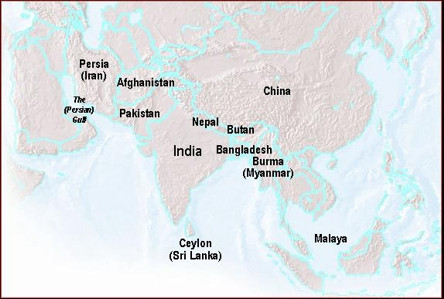Beginners' Guide
| See Peter Bailey's slideshow "Your First Visit to the IOR". |
The FIBIwiki contains lots of guidance for starting out on your British India research. It is recommended that you read through this page before contacting FIBIS for personal research services (Members) or research advice (non-Members).
Scope of FIBIS' Interest
The main focus of FIBIS activities is the ‘sub-continent’ of India but the society is also interested in all areas and activities of the British in South Asia including the following between the founding of the East India Company in 1599 to ‘Indian Independence’ in 1947:
Afghanistan, Aden, Andaman Islands, Bangladesh, Bencoolen (Sumatra, Indonesia), Burma (Myanmar), Ceylon (Sri Lanka), China, Macao & Hong Kong, Indonesia (Borneo, Labuan etc.), Malaysia, Mauritius, Persia, Singapore, Straits Settlements.
Also included are the activities of the East India Company in London and St. Helena.
Presidencies

British India was divided into three Presidencies:
- Bombay, which covered the smallest area on the west of the country, extending through Sind and to the coastal area of what is now Pakistan, including Karachi and also included Aden
- Bengal, which covered the east of the country and included Burma and what is now Bangladesh and extended to the North West Frontier to include most of modern day Pakistan, including Lahore, Multan, Peshawar and Rawalpindi
- Madras, which covered the southern portion of India
The main cities of the Presidencies were Bombay, Calcutta and Madras, respectively.
Knowing which Presidency a town or city was in, is important when consulting many of the India Office Records held at the British Library.
Also note that administrative boundaries changed from time to time and it is important to check 'border' districts in the adjoining area. The above map is adapted from Plate 21 of the (1931) revised atlas of the Imperial Gazetteer of India. Such small scale maps cannot show every enclave of territory, and this map is not to be taken as an authority for boundaries. For more detail see the provincial maps in the Imperial Gazetteer atlas, and large scale published Survey of India topographical maps.
Recommended steps for your research
The very first steps
- Search the archives of the India List. You may find that someone else has already researched the family tree you are interested in. Read how to do this, and more about the India List, in the Fibiwiki link Mailing lists
- Search the main online data bases. There are three of these, FIBIS; the IGI index on Family Search, the website of the LDS or Latter Day Saints Church (Mormons); and the British Library site, India Office Family History Search. Depending on the dates you are interested in, one site may provide more information than another. Unfortunately there is not a lot of information available for the 1900’s. To access the links for these data bases, and for more information, read
- When you have some identifying details of a person such as name, date and place(presidency), you might wish to join the India List (see above) and send an email to the list, asking whether anyone has any knowledge of the family.
The next steps
- Read the Fibiwiki article Birth, marriage and death records and all the associated articles and links
- By now, you may have some occupational details.
- For officers and soldiers in the Military, read Armies in India and all the associated articles and links which are relevant to your research.
- Look at Category:Occupations, and read the articles and links about occupations relevant to your research.
Further steps
- Look at Category:Research methods, and Category:Records and read the articles.
- Browse the remaining categories on the Main Page
